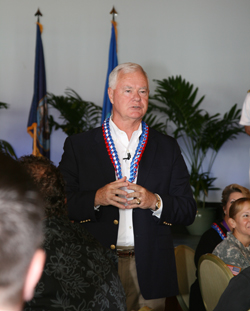TechNet Asia-Pacific 2011 Online Show Daily: Day 1
The future is in the East, and the United States must adapt to ensure that it can meet the challenges of the Asia-Pacific region in the 21st century. These challenges are complex and diverse, and the U.S. military must carry out an increasingly changing mission under tightening budget constraints.
Many of these challenges were explored by high-ranking officials and experts at TechNet Asia-Pacific 2011, being held November 1-3 in Honolulu, Hawaii. Many of these experts emphasized that these challenges also are opportunities, but the United States must be prepared to meet them or face serious consequences in a vast region that comprises half the world’s population.
 |
| Adm. Timothy J. Keating, USN (Ret.), former commander of the U.S. Pacific Command, addresses the keynote breakfast audience from within the audience at TechNet Asia-Pacific 2011. |
Adm. Keating described the geopolitical focus as a pendulum swinging from the Middle East toward the Far East. With China and India spurring greater economic growth and influence in the region, the United States must shift its own military and governmental focus on maintaining relationships with dozens of countries across that vast area.
The admiral related that when he was PACOM commander, he and his staff visited more than 30 nations. In every nation, at some point in discussions, leaders would say to him that the United States was their indispensable partner. These nations did not want the United States to salt the Asia-Pacific region with military bases, but they did want—and still want—bilateral relationships that help them preserve peace and security. Maintaining relationships with the nations of that region was never more important than it is today, he emphasized.
Adm. Keating offered several warnings about U.S. policy in the region. He identified the South China Sea as a lightning rod for possible conflict. Many nations have interests there, he pointed out, and these interests could lead to a military conflict in the future.
But the one item that keeps the former PACOM commander awake at night is the threat of nuclear war between India and Pakistan. If another Mumbai-type attack kills hundreds of people and is traced irrefutably to terrorists operating from within Pakistan, India will not be able to stand idly by—it will launch retaliatory strikes against sites within Pakistan. In turn, Pakistan will react militarily to India’s invasion of its airspace and launch its own military strikes against India. With India’s military superiority, subsequent escalations would “tip the scales” more to India, leading Pakistan to resort to its nuclear option. This concern is at the top of Adm. Keating’s list of challenges, he said.
In warning that the United States should not let budget cuts hamstring policy in the Asia-Pacific region, Adm. Keating declared that U.S. forces must maintain a physical presence throughout the area. He said, “Virtual presence can equal absence,” a statement repeated almost verbatim by a later speaker, Lt. Gen. Duane D. Thiessen, USMC, commander, U.S. Marine Corps Forces Pacific. Gen. Thiessen cited the need for U.S. forces to have a forward presence, but he allowed that it will be different from traditional basing patterns.
In the future, U.S. forces in the Asia-Pacific region will face widely dispersed, relatively small unit engagements. This will be challenging for existing force concentrations, he noted, and it will require “more of everything and an increased capability for everything.” High mobility, good communications and effective logistics are prerequisites for U.S. military operations in that vast area.
Gen Thiessen pointed out that regional security and stability is “absolutely mandatory—it has to happen,” and it is a top priority for the United States. The phenomenal economic growth throughout the region over the past few years has occurred because of the lack of war. However, tension is built into the Asia-Pacific region, and it will not go away anytime soon. Tension that would destroy the peace would be devastating, the general stated, and the United States must adjust its capabilities so that it can ensure continued security into the future.
“It’s not the last 10 years; it’s the next 10 years that we need to focus on,” Gen. Thiessen declared.
On Day 2 of TechNet Asia-Pacific 2011: An address on security by Hewlett-Packard’s Tom Reilly, and panels covering social networking and the future Global Information Grid.




Comments